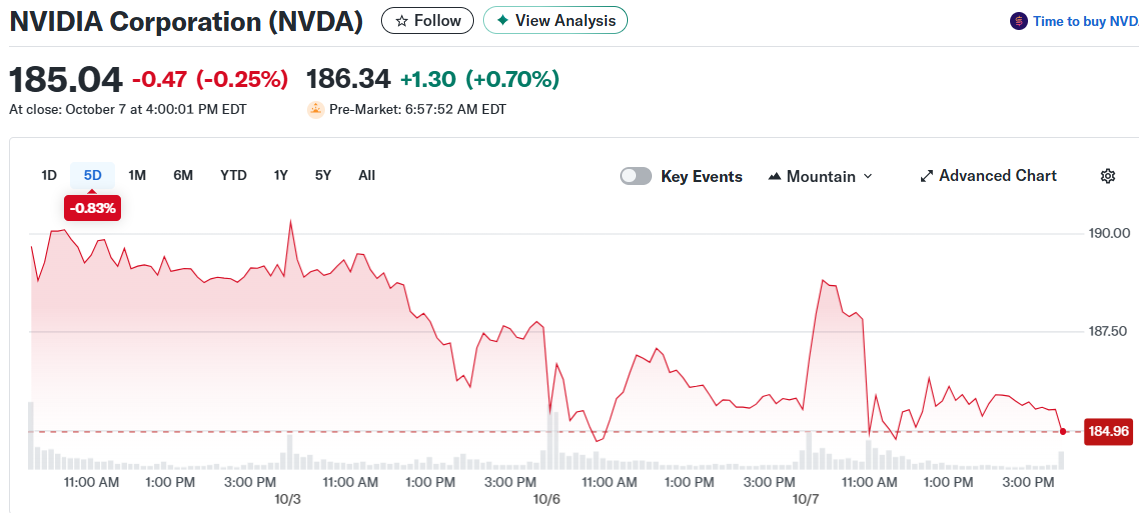TLDR
- Nvidia plans to invest up to $100 billion in OpenAI to lock in GPU sales and maintain chip market leadership
- Microsoft’s earlier OpenAI investment enabled Azure cloud integration and the $30/month Copilot assistant for Office apps
- The Nvidia deal ensures OpenAI remains a major customer for graphics processing units used in AI infrastructure
- Azure OpenAI Service helped Microsoft’s cloud platform grow 39% last quarter despite capacity limits
- Wall Street analysts give both stocks Strong Buy ratings with double-digit upside potential on price targets
Two tech giants have placed major bets on OpenAI, but their investment strategies couldn’t be more different. Nvidia is committing up to $100 billion to secure its hardware dominance. Microsoft invested earlier to integrate AI directly into its cloud and software products.
Nvidia’s massive investment targets the infrastructure powering artificial intelligence systems. The deal establishes OpenAI as a guaranteed long-term buyer of Nvidia’s graphics processing units. This relationship helps Nvidia defend its market position as AMD and Broadcom attempt to compete in AI chips.

The partnership provides Nvidia with valuable intelligence about future AI computing needs. Engineers from both companies will collaborate on chip design, software optimization, and system architecture. This collaboration allows Nvidia to build processors specifically tailored for next-generation AI workloads.
Nvidia’s CUDA platform remains the industry standard for AI development work. The company’s NVLink interconnect technology enables multiple GPUs to function as unified computing systems. These existing advantages combine with the OpenAI investment to strengthen Nvidia’s infrastructure business.
Microsoft Capitalizes on Early Access
Microsoft invested in OpenAI before the technology reached mainstream adoption. This early timing gave the company privileged access to language models ahead of competitors. Microsoft used this advantage to build commercial AI products that generate revenue today.

The Azure OpenAI Service allows enterprise customers to deploy OpenAI models using Microsoft’s cloud infrastructure. This offering has driven rapid growth for Azure. Last quarter alone, Azure revenue jumped 39% as businesses adopted AI capabilities for their operations.
Microsoft embedded OpenAI technology into Office applications through its Copilot assistant. The tool helps users create documents, analyze spreadsheets, and write code using natural language commands. At $30 per user monthly, Copilot adds a recurring revenue stream to Microsoft’s productivity software business.
Different Market Positions
Nvidia supplies the computing hardware that makes AI systems run. Microsoft delivers the software applications that put AI capabilities in users’ hands. Both approaches target the AI market but operate at different technology layers.
The Nvidia investment guarantees chip sales to one of the world’s largest AI developers. OpenAI will channel investment funds back to Nvidia by purchasing or leasing GPU hardware. This cycle reinforces Nvidia’s position as the essential provider of AI computing infrastructure.
Microsoft turned its OpenAI partnership into products that customers pay for immediately. Azure cloud services and Office applications now include AI features that drive subscription growth. This integration has accelerated revenue across Microsoft’s business divisions.
Analyst Outlook on Both Stocks
Wall Street maintains Strong Buy recommendations for both companies. Nvidia shares trade at $185.04 with analyst price targets averaging $218.14. Microsoft stock sits at $523.98 with targets of $629.22. These projections suggest potential gains of 17.89% and 20.08% respectively.
Nvidia earned a Smart Score of 9 while Microsoft received an 8. These ratings reflect institutional investor sentiment and analyst confidence. Both stocks rank among the top AI investment opportunities based on growth prospects in cloud computing and artificial intelligence markets.


